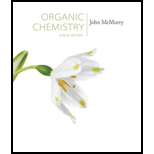
Concept explainers
Interpretation:
Imagining that the
Concept introduction:
The acid protonates the epoxide and then water attacks the protonated epoxide to yield the
To draw:
The structure of the epoxide with stereochemistry.
To give:
The name and structure of the product with stereochemistry.
To explain:
Whether the product is chiral or not and whether the product is optically active or not.
Trending nowThis is a popular solution!

Chapter 18 Solutions
Organic Chemistry
- Treatment of -D-glucose with methanol in the presence of an acid catalyst converts it into a mixture of two compounds called methyl glucosides (Section 25.3A). In these representations, the six-membered rings are drawn as planar hexagons. (a) Propose a mechanism for this conversion and account for the fact that only the OH on carbon 1 is transformed into an OCH3 group. (b) Draw the more stable chair conformation for each product. (c) Which of the two products has the chair conformation of greater stability? Explain.arrow_forwardWhat are the products obtained (2 stereoisomers A and B) when (Z)-hex-3-ene is treated with Br2 in anhydrous medium? Show the mechanism of this reaction. When the dibromide formed is treated with KOH in EtOH, only (Z)-3-bromohex-3-ene. Explain this result and justify why the E isomer cannot be obtained here. here.arrow_forwardDraw the structures and specify the stereochemistry of compounds A-C.arrow_forward
- Draw the products for the following chemical reactions, indicating stereochemistry wherever applicable. Indicate if the reaction proceeds via SN1 or SN2 mechanismarrow_forwardWhen attached halohydrin is treated with NaH, a product of molecular formula C4H8O is formed. Draw the structure of the product and indicateits stereochemistry.arrow_forwardClopidogrel is the generic name for Plavix, a drug used to prevent the formation of blood clots in patients that have a history of heart attacks or strokes. A single enantiomer of clopidogrel can be prepared in three steps from the chiral αhydroxy acid A. Identify B and C in the following reaction sequence, and designate the conguration of the enantiomer formed by this route as R or S.arrow_forward
- Draw the products formed when both cis- and trans-but-2-ene are treated with a peroxyacid followed by -OH (in H2O).Explain how these reactions illustrate that anti dihydroxylation is stereospecic.arrow_forwardWhen (R)-6-bromo-2,6-dimethylnonane is dissolved in CH3OH, nucleophilic substitution yields an optically inactive solution. When the isomeric halide (R)-2-bromo-2,5-dimethylnonane is dissolved in CH3OH under the same conditions, nucleophilic substitution forms an optically active solution. Draw the products formed in each reaction, and explain why the difference in optical activity is observed.arrow_forwardDraw the products formed when each alkene is treated with BH3 followed by H2O2,HO−. Include the stereochemistry at all stereogenic centers.arrow_forward
- Draw the products formed when both cis- and trans-but-2-ene are treated with OsO4, followed by hydrolysis with NaHSO3 + H2O. Explain how these reactions illustrate that syn dihydroxylation is stereospecific.arrow_forwardAn acid–base reaction of (R)-sec-butylamine with a racemic mixture of 2-phenylpropanoic acid forms two products having different melting pointsand somewhat different solubilities. Draw the structure of these twoproducts. Assign R and S to any stereogenic centers in the products.How are the two products related? Choose from enantiomers,diastereomers, constitutional isomers, or not isomers of each other.arrow_forwardWhich reaction below gives a single enantiomer of a chiral product?arrow_forward

 Organic ChemistryChemistryISBN:9781305580350Author:William H. Brown, Brent L. Iverson, Eric Anslyn, Christopher S. FootePublisher:Cengage Learning
Organic ChemistryChemistryISBN:9781305580350Author:William H. Brown, Brent L. Iverson, Eric Anslyn, Christopher S. FootePublisher:Cengage Learning

